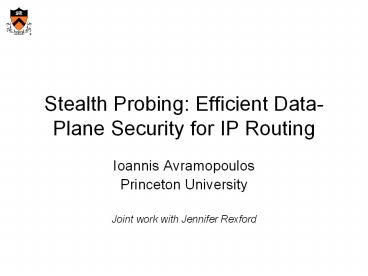Stealth Probing: Efficient Data-Plane Security for IP Routing - PowerPoint PPT Presentation
Title:
Stealth Probing: Efficient Data-Plane Security for IP Routing
Description:
Stealth Probing: Efficient Data-Plane Security for IP Routing. Ioannis Avramopoulos ... Stealth probing does not rely on clock synchronization ... – PowerPoint PPT presentation
Number of Views:22
Avg rating:3.0/5.0
Title: Stealth Probing: Efficient Data-Plane Security for IP Routing
1
Stealth Probing Efficient Data-Plane Security
for IP Routing
- Ioannis Avramopoulos
- Princeton University
- Joint work with Jennifer Rexford
2
Hosts vis-à-vis Routers(Attacks against
Availability)
3
Routing Fabric(Routing Protocols)
4
Routing Fabric(Data Forwarding)
5
Attacks against the Routing Fabric(Breaking
Perimeter Defense)
Perimeters can be broken because of
Disgruntled network operators
Password guessing
Exploits of the OS
6
Attacks against the Routing Fabric(Routing
Protocol Attacks and Defenses)
- These attacks game the routing state by
falsifying routing protocol messages - Falsifications come in two flavors
- Modification of en-route protocol messages
- Collusion (or wormhole) attacks
- Secure routing protocols protect from the
modification of protocols messages - They do not protect from wormholes
- They do not verify forwarding behavior
7
Limitation of Secure Routing Protocols(Data-Plane
Adversary)
8
Attacks against the Routing Fabric (Data-Plane
Attacks)
- Link layer disruption
- Physical layer attacks
- Medium access control layer attacks
- Network layer disruption
- Packet loss
- Packet modification
- Packet delay
- Packet deflection
- Transport layer disruption
- Attacks against the congestion control mechanism
9
Securing the Routing Fabric(Defending against
Data-Plane Attacks)
- Availability monitoring
- Easy for the traffic source
- Difficult from within the network
- Fault localization
- Beaconing and traceroute egregiously fail in
adversarial networks - In adversarial networks, fault localization is
difficult but necessary
10
Overview
- Introduction
- Stealth Probing
- Intradomain Deployment -- Byzantine Tomography
- Interdomain Deployment -- Secure Route Control
- Related Work
- Conclusion
11
Availability Monitoring(Problem Formulation)
12
Naïve Solutions
- Probing (e.g., ping)
- Cumulative network-layer ACKs
- Transport-layer ACKs
ingress
egress
13
Stealth Probing(Approach)
- Prevent the adversary from preferentially
treating probing traffic by making data and
probing traffic indistinguishable - Three steps
- Create an encrypted tunnel and divert both data
and probing traffic in the tunnel - Match the size of probing traffic with that of
the data traffic - Obscure the timing of probes
14
Stealth Probing(Approach---continued)
ingress router
egress router
15
Stealth Probing(Approach---continued)
ingress router
egress router
16
Stealth Probing(Primary Benefits)
- Non-intrusive (low overhead)
- Detects delay attacks (by measuring the
round-trip-times of probing traffic) - Prevents selective low-rate attacks that target
individual IP addresses (by hiding the source and
destination IP addresses of data traffic) - Mitigates attacks that exploit TCP (by making the
TCP mechanism opaque)
17
Stealth Probing(Secondary Benefits)
- Encryption protects unencrypted host-to-host
communications - Fate-sharing between data traffic and probes is
broadly useful in network troubleshooting - Tunnels are useful in traffic engineering
18
Overview
- Introduction
- Stealth Probing
- Intradomain Deployment -- Byzantine Tomography
- Interdomain Deployment -- Secure Route Control
- Related Work
- Conclusion
19
Basic idea
- Fault localization without overburdening the data
plane - Terminal nodes monitor path availability
- Terminal nodes disclose faulty paths to a
designated network entity - This entity triangulates adversarial nodes and
links from the collection of faulty paths
20
Byzantine Tomography(Model)
21
Byzantine Tomography(Approach)
Solves Minimum Hitting Set
22
Byzantine Tomography(Basic Property)
- Output from Byzantine tomography is not always
accurate - However, accuracy increases as fault knowledge
expands - Therefore, the higher the adversarys impact, the
more likely it is that the adversary will be
correctly detected
23
Overview
- Introduction
- Stealth Probing
- Intradomain Deployment -- Byzantine Tomography
- Interdomain Deployment -- Secure Route Control
- Related Work
- Conclusion
24
Secure Route Control
AS B (Stub)
Provider
Provider
Provider
Provider
Provider
AS A (Stub)
25
Secure Route Control (cont.)
AS B (Stub)
Provider
Provider
Provider
Provider
Provider
AS A (Stub)
26
Overview
- Introduction
- Stealth Probing
- Intradomain Deployment -- Byzantine Tomography
- Interdomain Deployment -- Secure Route Control
- Related Work
- Conclusion
27
Related Work
- Perlman proposed encryption to make data and
control traffic indistinguishable - Perlman proposed encryption at network links
- We extend this idea to network paths
- Mizrak et al. proposed Fatih as a secure
data-plane availability monitor - Fatih requires clock synchronization
- Stealth probing does not rely on clock
synchronization - Several researchers have proposed data-plane
mechanisms for secure fault localization - Byzantine tomography is a management-plane
technique
28
Conclusion (1)
- Resilience was a top priority in the design of
the operational Internet but the threat model was
naïve (vis-à-vis todays attacks) - In future networks, we should expect to see
- better perimeter defense and
- in-depth defense
- secure routing protocols
- secure data forwarding
- Stealth probing is a secure availability monitor
that works by concealing probing traffic
29
Conclusion (2)
- We presented deployment scenarios of this monitor
in - Intradomain routing and
- Interdomain routing
- Our ongoing work focuses on
- Intradomain case improving the accuracy of
Byzantine tomography - Interdomain case investigating the benefits of
more flexible interdomain path selection schemes
30
Thank you
- Questions































